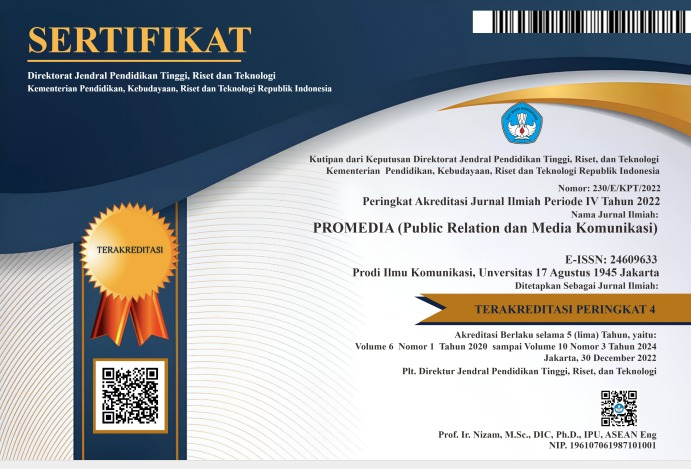Permainan Daring sebagai Medium Penyebaran Hate Speech: Dampaknya terhadap Anak dan Strategi Penanggulangannya dalam Perspektif Ilmu Komunikasi
Abstract
Full Text:
PDF (Bahasa Indonesia)References
Amin, R. F. (2020). Computer mediated communication (cmc) dalam pembelajaran bahasa inggris. LISAN AL-HAL: Jurnal Pengembangan Pemikiran Dan Kebudayaan, 14(2), 341–360. https://doi.org/10.35316/lisanalhal.v14i2.796
Anderson, C. A., Suzuki, K., Swing, E. L., Groves, C. L., Gentile, D. A., Prot, S., Lam, C. P., Sakamoto, A., Horiuchi, Y., Krahé, B., Jelic, M., Liuqing, W., Toma, R., Warburton, W. A., Zhang, X.-M., Tajima, S., Qing, F., & Petrescu, P. (2017). Media Violence and Other Aggression Risk Factors in Seven Nations. Personality and Social Psychology Bulletin, 43(7), 986–998. https://doi.org/10.1177/0146167217703064
Campbell, O. J. (2021). Tech Companies Want to Tackle Harassment in Gaming. Www.Wired.Com. https://www.wired.com/story/tech-companies-harassment-gaming-riot-intel-microsoft/
Cheung, C. M. K., Wong, R. Y. M., & Chan, T. K. H. (2020). Online disinhibition: conceptualization, measurement, and implications for online deviant behavior. Industrial Management & Data Systems, 121(1), 48–64. https://doi.org/10.1108/IMDS-08-2020-0509
Costa, S., Mendes da Silva, B., & Tavares, M. (2021). Video games and gamification against online hate speech? 10th International Conference on Digital and Interactive Arts, 1–7. https://doi.org/10.1145/3483529.3483679
Desiana, & Marlina. (2022). Online Game and Children’s Communication Ability. Konfrontasi: Jurnal Kultural, Ekonomi Dan Perubahan Sosial, 9(2), 283–290. https://doi.org/10.33258/konfrontasi2.v9i2.215
Guuru, T. W., & Adede, O. A. (2022). Effect of Communication Strategies on the Successful Implementation of Programmes at the International Livestock Research Institute, Kenya. European Journal of Business and Management Research, 7(4), 237–244. https://doi.org/10.24018/ejbmr.2022.7.4.1388
Hassim, M. N., Mohamad Nasir, N. N. A., & Zamri, N. A. K. (2024). Hate speech in the digital age: a study in terms of impact and social implications. International Journal of Law, Government and Communication, 9(38), 01–12. https://doi.org/10.35631/IJLGC.938001
Jamil, A. N., & Hastuti, R. (2025). Gambaran penggunaan abusive language dan hate speech pada siswa sekolah dasar yang ditirukan dari media sosial. PAEDAGOGY : Jurnal Ilmu Pendidikan Dan Psikologi, 4(4), 567–579. https://doi.org/10.51878/paedagogy.v4i4.4176
Koley, T. (2022). Hate speech in video games: A social media problem. Www.Hertie-School.Org. https://www.hertie-school.org/en/digital-governance/research/blog/detail/content/hate-speech-in-video-games-a-social-media-problem?
Kowert, R., Kilmer, E., & Newhouse, A. (2024). Taking it to the extreme: prevalence and nature of extremist sentiment in games. Frontiers in Psychology, 15. https://doi.org/10.3389/fpsyg.2024.1410620
Kwak, H., Blackburn, J., & Han, S. (2015). Exploring Cyberbullying and Other Toxic Behavior in Team Competition Online Games. Computer and Society, 1–11.
Lestari, A., Sunra, L., & Abdullah. (2023). The communication strategies in conveying effecitve and efficient message construction in tourism industry. ELITERATE: Journal of English Linguistics and Literature Studies, 3(2), 38–53.
Makarova, E. L., & Makarova, E. A. (2019). Aggressive Behavior in Online Games and Cybervictimization of Teenagers and Adolescents. Lnternational Electronic Journal of Elementary Education, 12(2), 157–165. https://doi.org/10.26822/iejee.2019257663
Meriläinen, M., & Ruotsalainen, M. (2024). Online Disinhibition, Normative Hostility, and Banal Toxicity: Young People’s Negative Online Gaming Conduct. Social Media + Society, 10(3). https://doi.org/10.1177/20563051241274669
Moreno-López, R., & Argüello-Gutiérrez, C. (2025). Violence, Hate Speech, and Discrimination in Video Games: A Systematic Review. Social Inclusion, 13. https://doi.org/10.17645/si.9401
Munawir, A. (2019). Online game and children’s language behavior. IDEAS: Journal on English Language Teaching and Learning, Linguistics and Literature, 7(2). https://doi.org/10.24256/ideas.v7i2.1050
Paz, M. A., Montero-Díaz, J., & Moreno-Delgado, A. (2020). Hate Speech: A Systematized Review. Sage Open, 10(4). https://doi.org/10.1177/2158244020973022
Silvia, M., Rousta, D., & Gilrandy, D. (2022). Application of Computer-Mediated Communication Theory in Online Learning. Jurnal Komunikasi Indonesia, 11(2). https://doi.org/10.7454/jkmi.v11i2.1032
Soral, W., Świderska, A., Puchała, D., & Bilewicz, M. (2024). Desensitization to hate speech: Examination using heart rate measurement. Aggressive Behavior, 50(1). https://doi.org/10.1002/ab.22118
Sorong, M. J. (2019). Penempatan teori dalam ilmu komunikasi (kajian kepustakaan dalam perspektif deductive-interpretateive). Commed: Jurnal Komunikasi Dan Media, 4(1), 90–107.
Supriatno, D., Bachtiar, C., & Noeviyanti, I. (2022). Kekerasan Komunikasi Verbal oleh Anak Usia 11-12 Tahun dalam Game Online Free Fire. Jurnal Paradigma Madani, 9(1), 69–82. https://doi.org/10.56013/jpm.v9i1.1497
Tushnet, M. V. (2024). Hate Speech (24–30). https://doi.org/10.2139/ssrn.4849106
Wachs, S., Wettstein, A., Bilz, L., Krause, N., Ballaschk, C., Kansok-Dusche, J., & Wright, M. F. (2022). Playing by the Rules? An Investigation of the Relationship Between Social Norms and Adolescents’ Hate Speech Perpetration in Schools. Journal of Interpersonal Violence, 37(21–22), NP21143–NP21164. https://doi.org/10.1177/08862605211056032
Wells, G., Romhányi, Á., & Steinkuehler, C. (2025). Hate speech and hate-based harassment in online games. Frontiers in Psychology, 15. https://doi.org/10.3389/fpsyg.2024.1422422
Yahaya, F. Y., Azni, Z., Hassan, M. S., Suhaini, Badrin, F. D., Zulfikar, S., & Sahri, M. H. (2023). The Effect of Video Games Towards Children’s Communication. Journal of Information and Knowledge Management, 2, 351–358.
Zerfass, A., Verčič, D., Nothhaft, H., & Werder, K. P. (2018). Strategic Communication: Defining the Field and its Contribution to Research and Practice. International Journal of Strategic Communication, 12(4), 487–505. https://doi.org/10.1080/1553118X.2018.1493485
Zsila, Á., Shabahang, R., Aruguete, M. S., & Orosz, G. (2022). Toxic behaviors in online multiplayer games: Prevalence, perception, risk factors of victimization, and psychological consequences. Aggressive Behavior, 48(3), 356–364. https://doi.org/10.1002/ab.22023
DOI: https://doi.org/10.52447/promedia.v11i1.8370
Refbacks
- There are currently no refbacks.
 |  |  |  |
 |  |  |  |
 |  |  |


